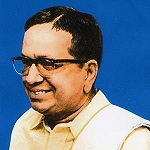Madurai Mani Iyer
 CHENNAI: Time was when the rickshaw-pullers in Mylapore would assemble for Madurai Mani Iyer’s concert, requesting their customers to wait until the event got over. Such was the verve with which Mani Iyer approached each raga in his natural and vibrant style. And that’s the reason why an evening to mark the 103rd birth anniversary of the veteran Carnatic vocalist turned out to be special on Sunday.
CHENNAI: Time was when the rickshaw-pullers in Mylapore would assemble for Madurai Mani Iyer’s concert, requesting their customers to wait until the event got over. Such was the verve with which Mani Iyer approached each raga in his natural and vibrant style. And that’s the reason why an evening to mark the 103rd birth anniversary of the veteran Carnatic vocalist turned out to be special on Sunday.
The event was organized by the members of the Madurai Mani Iyer Centenary Committee at PS High School, Mylapore. Music enthusiast V Vishnuramprasad played a rare collection of songs that the maestro had rendered at Anguvilas in Dindigul in February 1962 accompanied by his favorite mridangist Palani Subramaniam Pillai, the young Lalgudi Jayaraman on the violin and Alangudi Ramachandran on the ghatam.
The three-hour concert was recorded using an old tape-recorder. Apparently, it was not easy for Vishnuramprasad to collect that old record from Dindigul. “It took a long time to covert the tape-recorded version into MP3 format. But still, the quality is not that great. But this is a vintage collection and one of the best of Mani Iyer’s,” says Vishnuramprasad.
Songs like “Karunai seivai” in Hamsadwani and “O jagadamba” in Anandhabhairavi featured in the concert, were introduced after giving final touches to the old version. Similarly, ‘Kapali’ in Mohanam followed by a grand Thaniavarthanam by mridangist Palani and ghatam maestro Alangudi shows how Mani Iyer treated his percussionists. “Palani Subramaniam Pillai was his favorite mridangist. He was an unsung hero. The Dindigul concert was the last one that Palani and Mani Iyer shared together. Palani died after a couple of months,” he says.
Mani Iyer was born to M S Ramaswamy Iyer and Subbulakshmi on October 25, 1912 in Madurai. Veteran vocalist T V Sankaranarayanan is his nephew.
R Suryaprakash, a Carnatic singer who follows the Mani Iyer style, says, “It was Iyer who popularized the avarohana (descending scale) style in Carnatic music. His experiments with ragas opened a new world in Carnatic music. And it is still respected,” he says.
Ref: Times of India






Leave a Reply